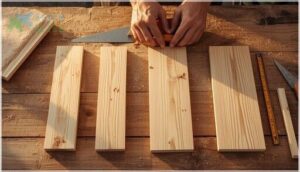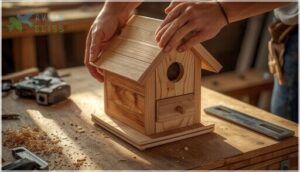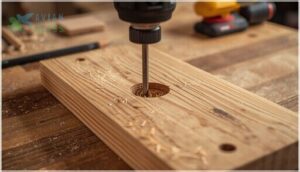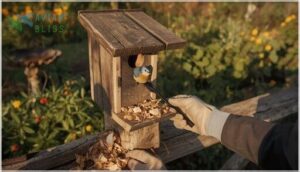This site is supported by our readers. We may earn a commission, at no cost to you, if you purchase through links.
A bluebird perched near your window isn’t just a cheerful sight—it’s a sign of a healthy ecosystem at work. These vibrant birds once nested in old fence posts and dead tree cavities, but modern landscapes have stripped away most of those natural homes. Without our help, bluebird populations struggle to find safe places to raise their young.
The good news? You can change that in a single weekend with basic tools and a few boards of cedar. Building a bluebird house gives these cavity-nesters exactly what they need while bringing natural pest control and biodiversity right to your backyard.
Once you understand the simple design requirements and placement strategies, you’ll create a nesting site that bluebirds return to year after year.
Table Of Contents
- Key Takeaways
- Why Build a Bluebird House?
- Choosing The Right Materials and Tools
- Step-by-Step Guide to Building a Bluebird House
- Installing Your Bluebird House
- Maintaining and Monitoring Bluebird Houses
- Frequently Asked Questions (FAQs)
- How do you make a simple bluebird house?
- How do you attract bluebirds to a new bluebird house?
- What is a simple Bluebird house?
- Do Bluebirds build their own nest?
- How do you build a Bluebird house?
- What are the best Bluebird house plans?
- Should you put up a birdhouse for bluebirds?
- What makes a house for bluebirds?
- Which direction should a bluebird house face?
- When should bluebird houses be put up?
- Conclusion
Key Takeaways
- Building a bluebird house with cedar wood and a 1.5-inch entrance hole creates essential nesting habitat where natural cavities have disappeared, directly supporting conservation efforts in areas where bluebirds have lost roughly 40% of their nesting sites.
- Proper placement matters as much as construction—mount your box 5-8 feet high in open areas with the entrance facing away from prevailing winds, spaced at least 30 meters from other boxes to reduce territorial conflicts.
- Bluebirds provide natural pest control by devouring beetles, caterpillars, and grasshoppers, turning your backyard into a hub for ecosystem balance while supporting pollinator populations and plant health.
- Regular maintenance after each brood—including cleaning out old nesting material within 24 hours of fledging and inspecting for damage or pests—ensures bluebirds return season after season to raise healthy families.
Why Build a Bluebird House?
Bluebirds need our help more than most people realize. Their natural nesting spots have been disappearing for decades, and that’s put their survival at risk.
Here’s why building a bluebird house matters so much for these beautiful birds and your own backyard.
Using the right birdhouse nesting box plans with rust-resistant hardware ensures your bluebird home stays sturdy and welcoming for years to come.
Importance for Bluebird Conservation
Your bluebird house isn’t just a backyard project—it’s a lifeline. In regions where habitat loss has hit hard, nest boxes create critical nesting success for cavity-dependent species. Here’s why your conservation efforts matter:
Building a bluebird house creates a lifeline for these cavity-dependent birds struggling against habitat loss
- Monitored nesting boxes show higher fledging rates than natural cavities
- Nest box programs support population growth amid agricultural and urban development
- Community projects expand citizen-science networks for wildlife conservation
- Your data helps track ecosystem balance and bluebird conservation efforts long-term
Effective conservation relies on scientific study methods to inform decision-making.
Decline of Natural Nesting Sites
Over the past half-century, bluebirds have lost roughly 40% of their nesting habitat in some regions. Old-growth trees disappear through logging, while urbanization fragments woodlands and creates dangerous gaps in breeding territories. Modern farming removes hedgerows and dead trees, climate change brings unpredictable storms, and predators thrive near human development.
To better understand the impact of these threats, researchers often study language patterns to identify key terms related to conservation efforts.
| Threat | Impact on Bluebirds |
|---|---|
| Habitat Loss | Fewer natural cavities available |
| Tree Removal | 40% reduction in nesting sites |
| Urbanization Effects | Fragmented breeding territories |
| Climate Change | Disrupted cavity formation |
That’s where your birdhouse steps in.
Benefits to Your Garden and Local Ecosystem
Your backyard becomes a hub for ecosystem balance when bluebirds move in. These insect-control champions devour beetles, caterpillars, and grasshoppers while fostering pollinator populations nearby. Here’s what a single nest box brings:
- Stronger pest suppression around your garden beds
- Higher chick survival during breeding seasons
- Improved plant health through enhanced biodiversity
- Early disease detection in local bird communities
- Hands-on wildlife conservation you can measure
Best of all, you’re creating a bird-friendly habitat that fosters environmental sustainability right where you live.
Tracking which species use your boxes helps you tailor your setup over time—here’s a guide to nesting box preferences by bird species to refine your approach.
Choosing The Right Materials and Tools
Building a birdhouse that lasts starts with choosing the right materials. Cedar stands out as the best wood for bluebird boxes because it resists rot naturally and won’t harm nesting birds with chemical treatments.
Let’s look at what you’ll need to build a safe, durable home that bluebirds will return to year after year.
Best Wood Types for Durability
When building a bluebird house, wood selection matters more than you’d think. Cedar benefits include natural rot resistance and insect-repelling oils, making it the top choice for birdhouse construction tips. Cypress offers similar durability factors for DIY bluebird house projects.
For sustainable sourcing and long-term performance, choose untreated cedar in your bluebird house plans—it’ll outlast pine while keeping your feathered friends safe from harmful chemicals in birdhouse materials.
For added durability and bird safety, consider easy-to-clean bird house designs with smooth interior surfaces that protect nestlings from injury.
Safe and Effective Fasteners
When securing your DIY bluebird house, fastener materials make all the difference in outdoor durability. Choose corrosion resistance by selecting galvanized or stainless steel screw types rather than standard nails—they’ll provide better wood protection and stand up to predators.
For step-by-step guidance on assembling all the components properly, check out this complete tutorial on how to build a birdhouse.
Pre-drill pilot holes to prevent splitting during birdhouse construction, then seal fastener heads with exterior-grade sealant. These birdhouse construction tips guarantee your DIY woodworking projects last for years of building a bluebird house success.
For proper ventilation and species-specific requirements, check the recommended entrance hole diameter before drilling your birdhouse front panel.
Essential Tools for Construction
You won’t need a fancy workshop to get started. Gather a cordless drill with various drill bits and driver bits, an adjustable hand saw for cutting wood, and a measuring tape with square for precision.
Add clamps to secure pieces during assembly, and you’re ready to build a safe haven that’ll welcome bluebirds for seasons to come.
Step-by-Step Guide to Building a Bluebird House
Building your bluebird house is easier than you might think. With your materials ready and a couple of hours to spare, you’ll have a safe nesting box that bluebirds will love.
Let’s walk through each step, from cutting the wood to adding those final touches that make all the difference.
Cutting and Preparing Wood Pieces
You’ll start with one 4-foot cedar board and a smaller 10½-inch piece. Wood selection matters—kiln-dried lumber won’t warp later.
Cut six pieces using a fine-tooth saw for clean edges: two sides, one front, one back, one bottom, and one roof. Precision crafting ensures proper fit.
Smooth all edges with sandpaper to protect nestlings and make cleaning easier. Your wooden structure building sets the foundation for successful DIY birdhouse projects.
Assembling The Box Structure
With your cut pieces ready, you’re tackling the heart of birdhouse construction—joining panels into a sturdy home. Start with exterior-grade glue along all joints, then pre-drill screw holes to prevent splitting. Fasten side panels to the back using corrosion-resistant screws, ensuring square corners throughout your wooden structure building.
- Align front, back, and side panels within a hairline for proper door clearance
- Apply weatherproof adhesive before seating at least three fasteners per joint
- Check internal dimensions match bluebird house plans before final assembly
Creating The Entrance Hole and Ventilation
Your entrance hole is where safety meets welcome—get it right and bluebirds will call your box home. Drill a clean 1.5-inch opening 6 to 8 inches from the base, centered on the front panel. Smooth any rough edges that could snag feathers. Then add two small ventilation holes near the top rear to keep air flowing without chilling eggs.
| Feature | Specification |
|---|---|
| Entrance hole size | 1.5 inches diameter |
| Hole placement | 6–8 inches from base |
| Ventilation holes | 1–2 openings, top rear |
| Edge finish | Smooth, splinter-free |
This nest box safety design keeps predators out while promoting airflow. Avoid placing vents directly over the cavity, and skip external perches that invite unwanted visitors. Your birdhouse construction now balances access with protection—exactly what bluebirds need.
Adding Drainage and Cleaning Access
A dry nest cavity means healthy broods, so proper drainage systems and cleaning access aren’t optional—they’re essential. Here’s how to finish your nest box with smart moisture control and maintenance features:
- Drill three 1/4-inch drainage holes at each corner of the floor panel to channel water out quickly.
- Add a hinged side panel secured with a galvanized screw for easy cleaning access between broods.
- Install ventilation holes near the roof peak to promote airflow and reduce humidity buildup.
- Apply weather-resistant sealant around access panels to keep rain from seeping inside during inspections.
- Position your cleaning door away from predator guards so you can reach in without removing safety hardware.
This birdhouse design keeps the interior dry while letting you remove old nesting material and check for pests after each fledging. Your bluebirds will return season after season when the box stays clean and well-ventilated.
Installing Your Bluebird House
You’ve built your bluebird house—now it’s time to give it a home where bluebirds will actually use it. Where you place the box and how you mount it can make or break your success in attracting these beautiful cavity nesters.
Let’s walk through the key factors that’ll help your bluebirds feel safe, stay protected from predators, and raise healthy broods year after year.
Ideal Placement and Height
Where you put your nest box matters more than you might think. For ideal height, mount the box between 5 and 8 feet above ground—this sweet spot balances predator avoidance with easy monitoring access. Face the entrance away from prevailing winds, and choose an open area with sparse ground cover, ideally near a fence post or small tree that acts as a natural perch.
| Placement Factor | Recommendation |
|---|---|
| Elevation Considerations | 5–8 feet above ground |
| Box Orientation | Face away from wind |
| Bird Habitat | Open fields, low vegetation |
| Nesting Site Selection | Near perching structures |
| Mounting and Placement | Clear 30-foot radius around entrance |
These placement strategies enhance your nesting box installation, creating a safe haven that bluebirds will return to season after season.
Mounting Methods and Hardware
Once you’ve picked the perfect spot, secure your nest box with hardware that lasts. Use stainless steel or galvanized lag screws for pole installation—they resist rust and hold firm through storms.
Attach brackets or U-bolts to solid wood, avoiding warped boards that shift over time. For wooden structures in DIY projects, corrosion-resistant fastener types guarantee your birdhouse construction stays level and stable, season after season.
Using Predator Guards for Safety
After securing your nest box with quality hardware, you’ll want to add a predator guard for extra nest safety.
These deterrents—made from hardened steel or durable mesh—create a barrier around the entrance that keeps raccoons, snakes, and climbing cats from reaching nesting sites.
Position guards to maintain at least 12 inches of protection while letting bluebirds enter freely, ensuring true bird protection without blocking ventilation.
Direction and Spacing Considerations
Once your predator guard is in place, focus on nest box orientation and wind direction. Face the entrance hole away from prevailing winter winds to reduce drafts.
Space boxes at least 30 meters apart to minimize territorial squabbles. Avoid direct light from streets or porches, and stagger mounting heights by 4–6 meters when installing multiple nesting sites.
These simple adjustments improve habitat diversity and birdhouse design success.
Maintaining and Monitoring Bluebird Houses
Building your bluebird house is just the beginning—keeping it in good shape matters just as much. Regular care helps bluebirds thrive and encourages them to return season after season.
Here’s what you need to know about maintenance, inspections, and making your yard a bluebird haven.
Cleaning After Each Brood
You’ll want to tackle nest box sanitation within 24 hours after the young bluebirds leave. This brood cycle management keeps disease at bay and readies nesting sites for the next family. Wear gloves and follow these cleaning schedules:
- Remove all old nest material and debris from the bluebird nest box
- Scrub interior surfaces with mild soap, then rinse thoroughly
- Disinfect with diluted bleach (1:10 ratio) if you spot mold or parasites
- Let the box dry completely before reassembling
- Record cleaning dates to track bird behavior patterns
Inspecting for Damage or Pests
Vigilance keeps your nest box safe and sound. Check at least once per brood season for cracks, loose joints, or wood rot that compromise birdhouse construction.
Look inside for pest control signs like mites, beetles, frass, or webbing. Examine ventilation holes for blockages and note any predator prevention concerns—chewed entrance holes or scratches signal damage assessment needs.
Record findings to track nest inspection patterns and protect these essential nesting sites.
Tips for Attracting Bluebirds Year After Year
Year after year, success comes down to habitat creation and smart nesting box placement.
Keep your yard bird friendly with native grasses that support the bluebird diet of insects and beetles. Skip pesticides—they’re the enemy of attracting bluebirds to your yard.
Add perches near boxes, maintain predator control with guards, and embrace bird-friendly landscaping. Your gardening for wildlife efforts make all the difference.
Frequently Asked Questions (FAQs)
How do you make a simple bluebird house?
Start with untreated cedar or exterior-grade lumber cut into six pieces: front, back, two sides, bottom, and roof.
Drill a 1½-inch entrance hole, add ventilation gaps, attach drainage holes, then assemble your nest box with galvanized screws.
How do you attract bluebirds to a new bluebird house?
Place your nest box 5 to 6 feet high in open areas with short grass, face the entrance away from wind, add predator guards, and provide water within 100 feet during nesting season.
What is a simple Bluebird house?
A simple bluebird house features a single cavity with a 5-inch entrance hole, sloped roof for rain protection, ventilation gaps, drainage holes, and a hinged panel for easy cleaning after each nesting season.
Do Bluebirds build their own nest?
Female bluebirds construct their own nests inside cavities, weaving cup-shaped structures from grasses and pine needles.
Males guard territory while females gather nesting materials, carefully arranging soft linings for eggs.
How do you build a Bluebird house?
You’ll need cedar or exterior plywood, a saw, drill, and galvanized screws. Cut six pieces, drill a 5-inch entrance hole, assemble the nest box, add ventilation and drainage, then attach a hinged cleaning panel.
What are the best Bluebird house plans?
A bluebird house is a symbol of optimism in the conservation landscape.
The Peterson nest box—with its sloping roof and 5-inch entrance—remains the benchmark for eastern bluebird habitat and nest box designs.
Should you put up a birdhouse for bluebirds?
Yes, absolutely. Installing a nest box directly aids conservation efforts by creating safe nesting sites where natural cavities have vanished.
You’ll boost local bluebird habitat, improve nesting success, and enjoy rewarding backyard birding.
What makes a house for bluebirds?
A sanctuary starts with the right blueprint. Your nest box needs a 5-inch entrance design, proper ventilation systems, effective drainage, and predator guards to keep bluebirds safe while nesting.
Which direction should a bluebird house face?
Face your entrance hole southeast to south, away from prevailing winds. This orientation tips toward morning sun exposure while protecting the nest from cold gusts, improving nest temperature stability and predator avoidance around your birdhouse design.
When should bluebird houses be put up?
Like gardeners planting seeds before the thaw, you’ll want to install nest boxes in late winter or early spring—usually March through early April—so bluebirds discover ready shelters when they arrive seeking territories.
Conclusion
Think of your bluebird house as a bridge between vanished habitats and thriving populations. Each box you build reconnects these birds to landscapes that once welcomed them freely.
You’ve now learned how to build a bluebird house that mirrors what nature provided before fence rows disappeared and dead trees were cleared away. Mount it properly, check it faithfully, and watch as your simple weekend project becomes a springboard for new generations taking flight.
- https://www.quartoknows.com/books/9780760368626/Audubon-Birdhouse-Book-Revised-and-Updated.html
- https://www.youtube.com/watch?v=8CSe-xCmWyE
- https://x.com/godofprompt/status/1990526288063324577
- https://www.onelook.com/?loc=olthes1&w=subpoint
- https://www.sciencedirect.com/science/article/pii/S0749208123000268











